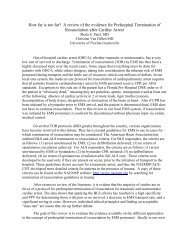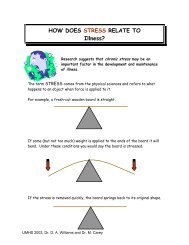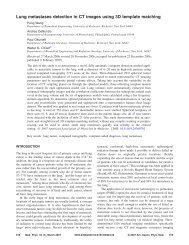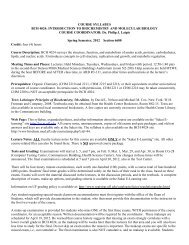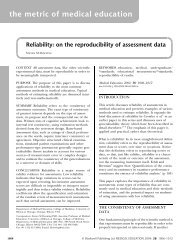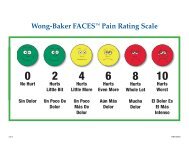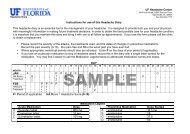imaging three-dimensional cardiac function - Walter G. O'Dell, PhD
imaging three-dimensional cardiac function - Walter G. O'Dell, PhD
imaging three-dimensional cardiac function - Walter G. O'Dell, PhD
Create successful ePaper yourself
Turn your PDF publications into a flip-book with our unique Google optimized e-Paper software.
Annu. Rev. Biomed. Eng. 2000.2:431-456. Downloaded from arjournals.annualreviews.orgby UNIVERSITY OF ROCHESTER LIBRARY on 07/27/09. For personal use only.?IMAGING 3-D CARDIAC FUNCTION 433Various <strong>imaging</strong> modalities exist to measure heart wall geometry. These can becompared objectively by the following criteria: signal quality [indicated by thesignal to noise ratio (SNR)], discrimination between myocardial and neighboringtissue [indicated by the contrast to noise ratio (CNR)], temporal and spatial resolution,susceptibility to image blurring and artifact, acquisition and analysis time,ease of use, relative cost, and availability. For accurate quantification of heart wallgeometry and ventricular volumes, CNR is often the more informative measurebecause it governs the ability to discern tissue boundaries. Spatial resolution is typicallygiven by the pixel dimensions in the two-<strong>dimensional</strong> (2-D) image (voxeldimensions for 3-D); however, for some modalities, such as MR <strong>imaging</strong> (MRI)and computed tomography (CT), the image slice thickness can be comparativelylarge, leading to partial-volume artifacts that diminish the effective in-plane resolution.Temporal resolution relates to both the time interval between successiveimages (temporal sampling rate) and the time over which the data for each imageare acquired (acquisition window). In X-ray <strong>imaging</strong>, motion while the shutter isopen leads to blurring and loss of image quality. In MRI, motion during acquisitioncauses a phase dispersion across the image, creating a characteristic artifact.Generally one needs to acquire data on a time scale that is smaller than thefastest motions of interest. For a typical heart rate of 1 Hz, the duration of isovolumicrelaxation or isovolumic contraction is ∼100 ms; hence a temporal samplingrate of



